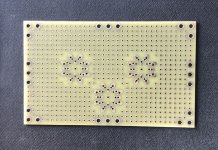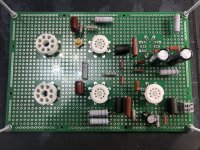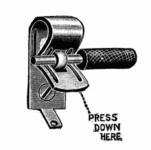I am interested in what you would recommend for small experiments, prototyping of ideas, and maybe just some tools in learning the basics of amplification using vacuum tubes. I know people actually still use real wood boards as the bread board. The Global Specialties PB series of breadboards are rated at 36V/1.5A max , so I guess would be suitable for 24V ideas. I would really like to know your favorite method or any ideas as it applies to my intended use, stated above.
Thanks for any help!
Alan
Thanks for any help!
Alan
What I've found the most useful is "building block" PCBs. I have a largeish (40 by 50cm) backplane of FR4 with a grid of holes drilled in it, and several smaller boards that each break out the pins of various tube sockets. This allows me to quickly assemble prototypes by adding "blocks" by screwing them to the backplane as needed. Tubes are pricey, sockets and passive components are usually cheap.
See the first few posts here for examples of similar "blocks": https://www.diyaudio.com/community/threads/v4lve-lovers-free-gerbers-thread.359636/
See the first few posts here for examples of similar "blocks": https://www.diyaudio.com/community/threads/v4lve-lovers-free-gerbers-thread.359636/
Lots of designs with schematics and component value alculator from Glassware Audio - Tube Cad and SE Amp Cad. well worth $10.
Pcbs or kits also available.
(Only works with 32bit XP)
Pcbs or kits also available.
(Only works with 32bit XP)
I use this relay sockets for tests with tubes with octal sockets:
https://cpc.farnell.com/schrack-te-connectivity/mt78755/socket-din-8-pin/dp/SW02629


https://cpc.farnell.com/schrack-te-connectivity/mt78755/socket-din-8-pin/dp/SW02629
Thank you very much, exactly what I was asking for. I happen to already be working on something similar but different using Belton sockets. Definitely looking for any other ideas. Thanks again!What I've found the most useful is "building block" PCBs. I have a largeish (40 by 50cm) backplane of FR4 with a grid of holes drilled in it, and several smaller boards that each break out the pins of various tube sockets. This allows me to quickly assemble prototypes by adding "blocks" by screwing them to the backplane as needed. Tubes are pricey, sockets and passive components are usually cheap.
See the first few posts here for examples of similar "blocks": https://www.diyaudio.com/community/threads/v4lve-lovers-free-gerbers-thread.359636/
Very cool! Looks like you are using a12V to high DC volt booster? Whats it boost up too?For 7 and 9 pin stuff, I built this:
View attachment 1088135
Great Idea.I use this relay sockets for tests with tubes with octal sockets:
https://cpc.farnell.com/schrack-te-connectivity/mt78755/socket-din-8-pin/dp/SW02629
View attachment 1088138View attachment 1088139
Yes. This one can give +- 45 - 390V. The output is noisy but it's good enough for testing. There's also a buck converter for the 6V heater and it can even light up a 6AS7G (takes a while, gets HOT).Very cool! Looks like you are using a12V to high DC volt booster? Whats it boost up too?
I also use sockets like planet IX for Octals.
I use my own design of prototyping boards 250x165mm (9.8x6.5"), FR-4 2mm thick, with universal pads, compatible with miniature noval B9A base (12AX7, 6N2P, ...), B7G heptal, octal (EL34, KT66, 6550, ...) and B8G loctal PCB-mounted sockets). Adjacent groups of holes on borderline connected together to make easy assembly of power rails. Having built 2 prototypes with cheap prototyping boards from eBay/Aliexpress, decided to make my own because cheap variants are too thin and flexible (only 1.5mm thickness), too small with a lot of wasted space for different socket types.
For smaller project use another board which is roughly 1/2 of this one.
Photo of work in progress attached.
For smaller project use another board which is roughly 1/2 of this one.
Photo of work in progress attached.
Attachments
Last edited:
Very nice! where do you buy your sockets. I get mine from Tubedepot, but they don't have the Octal style I want.I use my own design of prototyping boards 250x165mm (9.8x6.5"), FR-4 2mm thick, with universal pads, compatible with miniature noval B9A base (12AX7, 6N2P, ...), B7G heptal, octal (EL34, KT66, 6550, ...) and B8G loctal PCB-mounted sockets). Adjacent groups of holes on borderline connected together to make easy assembly of power rails. Having built 2 prototypes with cheap prototyping boards from eBay/Aliexpress, decided to make my own because cheap variants are too thin and flexible (only 1.5mm thickness), too small with a lot of wasted space for different socket types.
For smaller project use another board which is roughly 1/2 of this one.
Photo of work in progress attached.
From Aliexpress.Very nice! where do you buy your sockets. I get mine from Tubedepot, but they don't have the Octal style I want.
I have a bunch of these. They are designed for octal and noval sockets, but 7-pin sockets work too. I fitted some pins on the PCB so that I can make frequent soldered changes without worrying about the traces.
Prototype boards

Prototype boards
Cool, thanks for sharing!I have a bunch of these. They are designed for octal and noval sockets, but 7-pin sockets work too. I fitted some pins on the PCB so that I can make frequent soldered changes without worrying about the traces.
Prototype boards
View attachment 1088676
Lots of prototype options. Old Pomona breadboard sockets. Fahnstock clips and Spring-clips. An Octal Zif socket for wire lead sub-mini tubes. Pomona and Vector test extenders. Octal relay sockets. ( note the octal plug adapter with a 7 pin socket ) Tube adapter PC boards.




Very good, I have seen the clips before in pictures but am not sure how they work. do they plug into perf board some how (like ww pins) or do they solder in?
The spring clips were made for insertion into the old Vector perf board with big holes. I just drill a tight hole in the wood board and push them in. Some old electronics kits provided a plastic panel with molded in holes that the spring clips could be pushed into. The Fahnestock clips are convenient to put under the corner mounting bolts of the tube proto socket boards, or just put a woodscrew thru them into the wood board. You can generally get several wires into either kind. There were also some electronic kits that had tube sockets mounted on a plastic ring with tall vertical pins ( Octal pin size ) around them, which some forked wire springs could be pushed onto.
Last edited:
- Home
- Amplifiers
- Tubes / Valves
- vacuum tube prototyping methods


